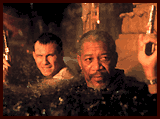Mikael Salomon, ASC confronts a deluge of logistical rigors during his second directorial effort.
Cinematographer-turned-director Mikael Salomon, ASC concedes that his latest project, Hard Rain (formerly titled The Flood), lived up to its title. However, he's quick to point out that his filmmaking team was undaunted by the film's soggy logistics. "We were working in 4' of water all the time and it was raining, but we didn't want those conditions to stop us from working the way we'd normally shoot a movie," says Salomon, who notes that the flood water was contained in a huge tank, while the rain fell from a network of pipes. "We wanted realism. When you see this picture, it will look like a normal movie, despite the fact that there's water everywhere."
Salomon, who began his film career in his native Denmark at the age of 17, made his directorial debut in 1993 with Amblin' Entertain-ment's A Far Off Place. He had already built an international reputation as a cinematographer, earning Academy Award and ASC Award nominations for his cinematography on The Abyss; an Oscar nomination (along with Allen Hall, Clay Pinney and Scott Farrar) for the visual effects in Backdraft (see AC May 1991), and a Cable Ace Award for cinematography on The Man Who Broke 1,000 Chains. Salomon's other credits as a director of photography include Far and Away (AC June '92), Always, Arachnophobia and Torch Song Trilogy.
Written by Brian Yost, Hard Rain is set in the small town of Huntingburg, Indiana, whose residents must evacuate after a series of heavy downpours causes a river to overflow. A pair of armored car drivers, Tom (Christian Slater) and his uncle Charlie (Ed Asner), are transporting $3 million in cash from the local banks to higher ground; along the way, however, they are stopped by Jim (Morgan Freeman) and his gang, who try to rob the couriers. Tom escapes with the money, but the robbers pursue him through increasingly dangerous floodwaters. With the town sheriff (Randy Quaid) occupied by the flood, Tom's only help comes from a gutsy young civilian named Karen (Minnie Driver).
Despite his many years as a cinematographer, Salomon found it surprisingly easy to hand the photographic work over to director of photography Peter Menzies Jr., ACS (see accompanying story on page 54). "This is my second movie as a director," he says. "The first time around, it was hard to let the cinematography go, but this time I was glad to do it because there was so much else to look after. When I met with Pete, we hit it off. He is a very gracious person to work with, and he always tried to accommodate what I wanted to do. I didn't ask him for the impossible, but sometimes I asked for something that would take a lot of doing. He had just come off A Time to Kill [see AC Aug. 1996], which I had seen and liked. I was also impressed by his work on The Getaway, White Sands and Posse I especially liked the look of Posse. "
The decision to shoot in Super 35 instead of anamorphic, for a widescreen presentation, was made for practical reasons. "If I were shooting a picture outdoors, I'd use anamorphic," Salomon insists. "But we had huge surfaces to cover, as well as scenes where I wanted to start with a tight close-up and go to a wide shot. That's hard to do with an anamorphic lens. I had used Super 35 twice before as a cameraman, on The Abyss and Backdraft, so I felt comfortable with the format."
Huntingburg, Salomon assures us, is a real town with a population of 1,200, located 50 miles northeast of Evansville. The filmmakers theorized that audiences would care more about the fate of an actual town, rather than a fictional locale. Huntingburg was selected after a widespread search, largely because it offered quaint old buildings set along peaceful, narrow streets.
The curious thing is that although the entire film occurs in Huntingburg, only a few scenes were shot there. Salomon reveals, "We did just five days of location work in Indiana, partly for the credit sequence." This remarkable four-minute opening smoothly combines miniature photography, helicopter footage and an extensive overhead tracking shot. The sequence begins with the Paramount Pictures mountain logo, travels down to a river and over a 100', 1/3-scale model dam, continues over action of flooding roads and fleeing residents, and ends in a 2,000' cable ride as a Cablecam equipped with a Wescam heads down Main Street and moves into a close-up of actor Randy Quaid.
Almost two-thirds of Hunt-ingburg's population answered the call for extras. The intersection of Main Street and Interstate 231 was blocked off and flooded for some exterior scenes, and the very last shot in the picture is a helicopter shot made in Indiana.
However, most of the filming took place in a replica of the town constructed on a five-acre stage in Building 703, a cavernous hangar at Rockwell International Airport near Palmdale, California. The facility offered a 100' ceiling with a clearance of 75'. Four 20-ton cranes once used to haul B-1 bomber aircraft components hung from the infrastructure. These cranes were invaluable for the hauling, raising and lowering of sets, trees and heavy equipment, as well as for holding the rainmaking rigs. This would not have been possible using Condors deployed around the perimeter of the stage, because they could not have extended over the center of the space.
"We had a tank built which was 680' x 250', and 4' deep," Salomon says. "Around that was a backing which was 2,200' long and 72' high the biggest backing ever built. We had 40' water dumpsters for the scenes where boats and vehicles were smashed by raging waters. We built numerous sets in the tank about 50 buildings, including a school, a church, a sheriff's station, a cemetery, and different areas of the town."
[ continued on page 2 ]
